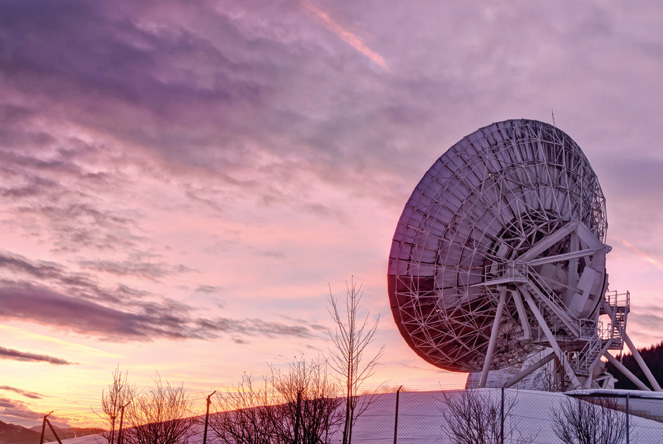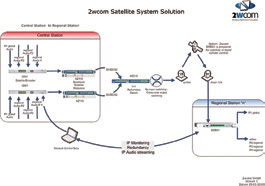The widespread revision and restructuring of satellite infrastructure taking place in the audio market today is due to a number of causes; the most important being the need to replace the outdated 1gen of satellite receivers, and the new palette of possibilities offered to audio broadcasters by audio over IP.

Broadcasters attempting to purchase the older generation or receivers find that such is no longer possible—plus, that equipment is inefficient in bandwidth use. The drive to greater operating economies is a powerful incentive to upgrade to receivers supporting more efficient standards, such as DVB-S2, as well as use the upgrade process to investigate the potential for audio over IP, or a hybrid combo of IP and satellite.
What To Look For
Certain trends are emerging as leading players investigate the potential of new satellite standards and look at how satellite can be combined with IP. Flexibility is one of the main requirements for many, and this reflects the wide variety of ways that broadcasters construct their infrastructure and the necessity of keeping options open to future change.
Flexibility—a key requirement for achieving economies as well as for raising revenues through regionalization. A more flexible generation of hardware is allowing operators to experiment with IP and IP/satellite hybrids more easily, in search of economies and more sophisticated regionalization. Broadcasters also want to improve their backup capabilities. The latest generation of hardware can make backup easier and more cost-effective to implement.
Broadcasters also want the flexibility offered by hardware based on open standards, rather than proprietary technology. Some manufacturers remain committed to the proprietary model. However, broadcasters are wise to steer clear of those models so they avoid getting locked into a single supplier and limited in their options for future network development.
Operating economies are, of course, high on the needs agenda for any network. The greater efficiency of DVB-S2 offers valuable savings. For even better use of bandwidth, broadcasters can install receiving devices that support codecs such as AAC and eAPTX. These codecs are ideal for studio-to-studio transmissions as the technology allows re-encoding of audio as many times as needed—without loss of quality.
Although audio content distribution by satellite is still the most reliable method, broadcasters are increasingly considering the possibility of OPEX reductions through the use of IP over DSL lines. IP can have a very useful role to play in audio distribution. If the hardware they select is flexible and incorporates built-in technologies such as FEC (Forward Error Correction) to improve the quality of IP transfers, broadcasters can be confident about using IP in their overall solution. IP support in today’s generation of satellite receivers gives broadcasters the option of using IP easily, if they wish to do so.
To meet these diverse requirements, the latest generation of hardware concentrates a wide range of functionality into a single chassis. This means that ‘satellite receiver’ is more or less obsolete as a term, as the best of the new devices can receive from IP as well as satellite. Advanced regionalization capabilities, backup solutions and more are combined into the same unit. ‘Contribution device’ may be a better description.
With the implementation of technologies like dual streaming and FEC, the best of the new generation of devices can increase the security of IP transmission—different types of IP feed, such as RTP and Icecast, are supported in order for operators to accommodate any kind of source and network configuration.
The interplay between IP and satellite varies from broadcaster to broadcaster. Those that go all-out for the economies of contribution over DSL lines may feel more able to do so if the infrastructure they have installed allows them revert to satellite whenever they want, without further capital cost.

Nothing Quite Like A Solid Mix
Another approach is to use a mix of IP and satellite as part of the backup strategy (with either IP or satellite as the main feed), or to achieve economies by sending some content—perhaps content of less critical importance—via IP, while using satellite for most of the feed. An example of this approach would be the broadcaster who contributes regionalized content via IP, while using satellite for the national feed. If the IP contribution of regionalized content fails, the regional audience then hears the national feed instead.
By concentrating the functionality required for regionalization into the same unit that receives the content, manufacturers allow broadcasters to dispense with limitations of a separate (usually PC-based) regionalization installation. The integrated contribution device can offer a highly streamlined, cost-effective and robust solution by receiving regionalized content either by a different route from the main feed (such as a DSL line), or in a side channel if satellite is used exclusively.
The regionalized content is stored onboard and, when a trigger signal from the headend is received by the device, that content plays out immediately. When a broadcast is implementing a regionalized operation over a network of several hundred receivers, the integrated contribution device is a much more efficient way to manage the process.
An integrated contribution device like this is also much easier and economical to operate remotely. With an optional dual power supply, and remote management inclusion, feature upgrades and software updates are far smoother to implement. Remote control and management can be effected through IP or directly by satellite through in-band control (SIRC). Built-in snmp support facilitates the integration of the devices into a network management system.
The broadcaster will find even more flexibility if the contribution device offers extremely accurate synchronization capabilities between multiple transmitters. This allows for the implementation of single frequency networks to optimize the use of FM frequencies as well as offering a valuable asset in non-SFN configurations to have micro-second accuracy built into the infrastructure.
More than ever before, equipment choice today has the potential to influence—positively or negatively—the future broadcaster’s business evolution. In today’s highly competitive commercial and technical climate, one that is far more fluid and diverse, flexibility and the ability to adapt, improve and grow without limitation is no longer a luxury—such is a key requirement to include in any new technology purchase.

For further details, please visit the company’s infosite at http://www.2wcom.com
About the author
Werner Drews is the founder and managing director of 2wcom Systems GmbH, a leader in the field of systems for wireless and digital information transfer. Holding a degree in Electrical Engineering and Computer Engineering, Werner Drews was a senior product manager with Rohde & Schwarz before establishing a spin-off company to develop products for FM/RDS systems. The company was founded in 1996 and is now a subsidiary of the WISI Group.


